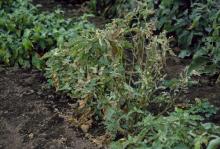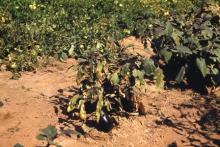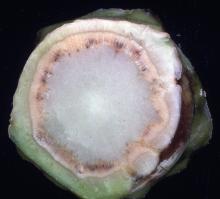See:
Pepper (Capsicum spp.) - Verticillium Wilt
Cause Verticillium dahliae, a fungus widespread in soil and that affects a wide range of herbaceous and woody plants. Once V. dahliae makes its way into a soil, the microsclerotia it produces in affected plant tissues can survive for a number of years in soil. It can also be seedborne in eggplant but not likely to be important in the overall disease cycle. Asymptomatic weedy hosts can also perpetuate the pathogen population. The fungus gains entry through the root system; progress in the plant is primarily through the vascular system. This species can cause disease in cooler soils and survives as resistant mycelium as it does not produce microsclerotia. Plant parasitic nematodes in the presence of Verticillium can result in severe disease.
Symptoms Infected plants are stunted, and leaves yellow and roll inward. Disease development on eggplant begins with a yellowing of the lower leaves, wilting, reduced growth, and vascular discoloration.
Cultural control
- Do not leave crop remains on the field or add them to the compost pile; this encourages future infections.
- Crop rotation with nonsusceptible grasses and grains is of value; 4- to 5-year crop rotation intervals should be followed in order for pathogen populations to drop as infected plant residues decompose.
- Do not rotate to tomato or potato. They are very susceptible hosts.
- The use of both black plastic mulch and ammonium sulfate fertilizers improved yields in Connecticut trials.
- Grow eggplant as grafts onto Verticillium-resistant tomato root stock.
Chemical control Preplant fumigation is recommended in the Hermiston, OR area.
- Vapam HL at various rates. See label for details. 48-hr reentry. Restricted-use pesticide.
Biological control
- Bexfond at 7 to 28 fl oz/A. 4-hr reentry. O
- Double Nickel LC at 1 to 2 quarts/A as a banded soil spray or drench on 4- to 6-week intervals or at 0.5 to 4.5 pints/A on 2- to 4-week intervals. Can be applied the day of harvest. 4-hr reentry. O
- Stargus at 6 to 8 fl oz per 1,000 ft row as an in-furrow treatment, or 3 to 4 quarts/A as a soil drench (drip or chemigation) on 10- to 21-day intervals. Preharvest interval is 0 days. 4-hr reentry. O
Reference Elmer, W.H. 2000. Comparison of plastic mulch and nitrogen form on the incidence of Verticillium wilt of eggplant. Plant Disease 84:1231-1234.




